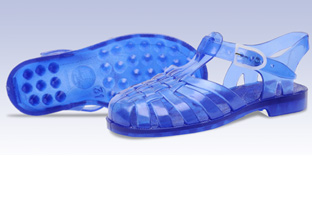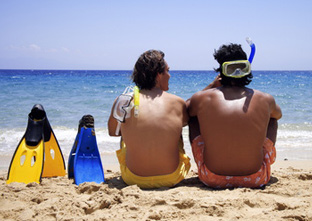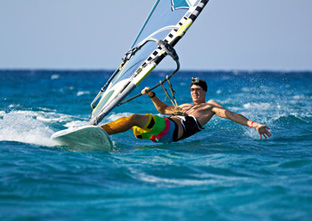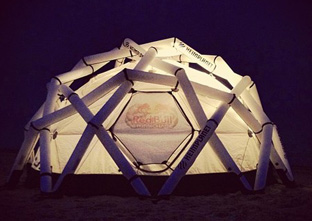
Plastics at the seaside
No time off for plastics!
The tourist is a funny kind of migrating creature in his own way. Like most of his breed, he lives in a town...which he flees once a year to live the beach life.
Every year, more than one in three Europeans decamp somewhere for summer depending on what they like and can afford - five-star hotel, holiday apartment complex, campsite...Like M. Hulot, “50 years ago, they will go sunbathing, swimming, paddling, fishing or frolicking with a beach ball...The only difference is the change in decor...Out go cotton, woven straw and bamboo! From ice buckets to pedal boats, everything is plastic now. Plastic, in fact, is what lets holidaymakers indulge in their favourite activities...And turn their favourite play area into a dump. Because, make no mistake: nearly 90% of the plastic that pollutes our coastlines is domestic in origin, and most of it comes from tourism. And while we take our litter home with us, not everyone is as scrupulous.

Everything for the sandcastle-builder
 Swimming over, the holidaymaker’s thoughts turn to building. And sand and water, even without cement, do the job nicely. It’s something that grips you in childhood and can go through to old age. It costs next to nothing and uses basic tools: bucket, sieve, shovel and rake...And for the more advanced, a watering can, wheelbarrow and moulds for styles and sea creatures.
Swimming over, the holidaymaker’s thoughts turn to building. And sand and water, even without cement, do the job nicely. It’s something that grips you in childhood and can go through to old age. It costs next to nothing and uses basic tools: bucket, sieve, shovel and rake...And for the more advanced, a watering can, wheelbarrow and moulds for styles and sea creatures.
Since the boom of the 1960s, polypropylene has ousted sheet metal in this branch of building on safety and comfort grounds! 2012, however, witnessed a major innovation in western France. A partnership between the toymaker Coq en Pâte and a Breton start-up means that budding builders can have tools in Algoblend - plastic made of a blend of polypropylene and a new polymer derived from algae.
Plastic’s got sole !
 Mass tourism is a sign of prosperity – but you wouldn’t know it from the “poverty chic” clothing that tourists wear. Step forward the "jelly sandal" and "flip-flop".
Mass tourism is a sign of prosperity – but you wouldn’t know it from the “poverty chic” clothing that tourists wear. Step forward the "jelly sandal" and "flip-flop".
Created in 1946 by Frenchman Jean Dauphant, the famous PVC sandals started out as everyday footwear in colonial Africa before being taken up by holidaymakers big and small. Branded as “uncool chav wear”, the "jelly sandal" suffered greatly from the “loadsamoney” mentality of the 1980s. But while globalization put paid to the family business, which went bust in 2002, it has not killed off either the brand or the concept.
With its moulded braided straps and textured tread, the old school model is still wowing holidaymakers on France’s Atlantic coast in a wide range of acid and glitter colours. Better yet, in a mere quarter-century, it has conquered the seaside resort world with the Aranha, a Brazilian version in recycled PVC sold under the Melissa brand.
Brazil is also where a plain vanilla, Japanese inspired flip-flop known as a “thong" has invaded the beaches. First with the natural rubber Havaianas which, in 50 years, have gone from the feet of shanty-dwellers to beach hipsters, then their designer rivals in recycled PVC - the Ipanema, named for the Rio beach that was the birthplace of the Bossa Nova and uber-cool trendy hangout for fashionistas.
Plastics – now you “sea” it ….
"Snorkelling", a sort of ramble-while-you-swim activity, is a popular recreation among holidaymakers, especially in the Mediterranean. With fewer risks than with scuba diving, it is the perfect pastime for the warm waters just offshore, needing only a dive mask, diving fins and a snorkel tube...
These accessories, for which we owe much to the ingenuity of diving pioneers and early enthusiasts like Paul Beuchat in Marseille (France), and the Cressi brothers in Genoa (Italy) are now within the reach of all thanks to advances brought by the use of new polymers.
While rubber has not been completely replaced, it is used only for the foot pocket part of fins. Their increasingly hydrodynamic blades are now made in polypropylene combined with one or even two other polymers.

 For dive masks, reputable manufacturers have gone with joint moulding of two types of silicone: a more flexible one for the skirt, and a more rigid durable one for the polycarbonate window. The snorkel is also composed of two polymers: silicon for the mouthpiece and PVC or polyurethane for the tube.
For dive masks, reputable manufacturers have gone with joint moulding of two types of silicone: a more flexible one for the skirt, and a more rigid durable one for the polycarbonate window. The snorkel is also composed of two polymers: silicon for the mouthpiece and PVC or polyurethane for the tube.
Other plastics will also be found kitting out the underwater stroller, most obviously neoprene foam, the iconic material of wetsuits. It is still used in layers of varying thickness, in combination with technical fabrics in the manufacture of insulated protection or anti-UV shorty wetsuits and tops.
In short, apart from the toughened glass dive mask window and the electronics in your waterproof camera, in this underwater world…plastic is definitely in the swim!
Plastic rules the waves
 Windsurfing, funboarding, kitesurfing, wakeboarding, wakesurfing, bodysurfing... the list of sliding and gliding sports is endless. Hardly a summer has gone by for 25 years without a new speciality popping up...And thrill-seeking holidaymakers have been quick to seize on less adrenaline-pumping sports.
Windsurfing, funboarding, kitesurfing, wakeboarding, wakesurfing, bodysurfing... the list of sliding and gliding sports is endless. Hardly a summer has gone by for 25 years without a new speciality popping up...And thrill-seeking holidaymakers have been quick to seize on less adrenaline-pumping sports.
Their emergence on the water sports market always follows the same pattern. “Shapers" respond to demand from the pros in the new discipline by developing a tailored sandwich float: a polystyrene or polyurethane foam core reinforced by several layers of composite, glass or carbon, covered with epoxy resin or polyester. The materials used, shaping techniques, resin blend and finishing are manufacturing secrets jealously guarded by each workshop to solve the eternal equation of strength and lightness.
A new style “shape” that wows holidaymakers and the media may be taken up by a major manufacturer. So no more homemade “sandwiches”! Industrial board manufacture involves processes like thermoforming of plastic hulls, either hollow or around a polystyrene core, as well as extrusion before being expansion-filled with polyurethane foam.
For wind sports, other polymers come into play, like carbon composites for masts and obviously the full range of high performance synthetic fibres for sailing: polyesters, polyamides, aramids or ultra-high-molecular-weight polyethylene...

More comfort on the open road
 Each year, more than a third of Europeans take their holidays in a tent or a caravan ...At least those who haven’t yet given in to the fashion-forward motorhome.
Each year, more than a third of Europeans take their holidays in a tent or a caravan ...At least those who haven’t yet given in to the fashion-forward motorhome.
Whatever the type of summer shelter they choose, the main thing is, it has to be lightweight. And that’s where plastics win in the design of equipment. Apart from the weight advantage, they also meet the camper’s other big bugbear: keeping dry in a downpour.
This obsession with weather-tightness has led many motorhome and caravan manufacturers to go with a polyester outer shell reinforced inside with polyurethane insulation which is sufficiently rigid to replace the old wooden frames.
 Camping purists also reap the rewards of the use of high performance polymers. Silicone or polyurethane coatings on polyester or nylon membranes have greatly improved waterproofing for tents while preserving their breathability. Titanium dioxide added to the outside and aluminium particles to the underside also give some models of tents thermal protection against sunlight.
Camping purists also reap the rewards of the use of high performance polymers. Silicone or polyurethane coatings on polyester or nylon membranes have greatly improved waterproofing for tents while preserving their breathability. Titanium dioxide added to the outside and aluminium particles to the underside also give some models of tents thermal protection against sunlight.
The hardwearing, weatherproof properties of plastic materials have also promoted a comeback for easy-build inflatable tents, the most innovative at present probably being the geodesic dome with external air struts designed by the young Hamburg-based start-up Heimplanet.





